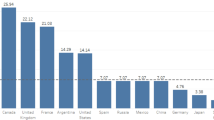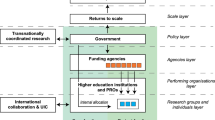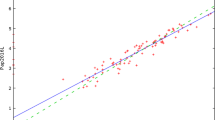Abstract
The term “European Paradox” describes the perceived failure of the EU to capture full benefits of its leadership of science as measured by publications and some other indicators. This paper investigates what might be called the “American Paradox,” the decline in scientific publication share of the U.S. despite world-leading investments in research and development (R&D) — particularly as that decline has accelerated in recent years. A multiple linear regression analysis was made of which inputs to the scientific enterprise are most strongly correlated with the number of scientific papers produced. Research investment was found to be much more significant than labor input, government investment in R&D was much more significant than that by industry, and government non-defense investment was somewhat more significant than its defense investment. Since the EU actually leads the U.S. in this key component, this could account for gradual loss of U.S. paper share and EU assumption of leadership of scientific publication in the mid-1990s. More recently the loss of U.S. share has accelerated, and three approaches analyzed this phenomenon: (1) A companion paper shows that the SCI database has not significantly changed to be less favorable to the U.S.; thus the decline is real and is not an artifact of the measurement methods. (2) Budgets of individual U.S. research agencies were correlated with overall paper production and with papers in their disciplines. Funding for the U.S. government civilian, non-healthcare sector was flat in the last ten years, resulting in declining share of papers. Funding for its healthcare sector sharply increased, but there were few additional U.S. healthcare papers. While this inefficiency contributes to loss of U.S. share, it is merely a specific example of the general syndrome that increased American investments have not produced increased publication output. (3) In fact the decline in publication share appears to be due to rapidly increasing R&D investments by China, Taiwan, S. Korea, and Singapore. A model shows that in recent years it is a country’s share of world investment that is most predictive of its publication share. While the U.S. has increased its huge R&D investment, its investment share still declined because of even more rapidly increasing investments by these Asian countries. This has likely led to their sharply increased share of scientific publication, which must result in declines of shars of others — the U.S. and more recently, the EU.
Similar content being viewed by others
References
AAAS (2005), Guide to R&D Data: Historical Data. Washington: American Association for the Advancement of Science. http://www.aaas.org/spp/rd/guihist.htm
Adams, J., Griliches, Z. (1996), Measuring science: An exploration. Proc. Natl. Acad. Sci. USA, 93: 12664–12670.
Archambult, E., Vignola-Gagne, E., Cote, G., Lariviere, V., Gingras, Y. (2005), Welcome to the linguistic warp zone: Benchmarking scientific output in the social sciences and humanities. Proceedings of the ISSI 2005 Conference, Stockholm, July 24–28, 2005. pp 149–158.
ISI (2004), National Science Indicators 1981–2004, Standard Version. Philadelphia: Thompson ISI. (CD). The 2004 edition was usually used since it has EU15 data, instead of the EU25 data in subsequent years.
Jin, B., Rousseau, R. (2005), China’s quantitative expansion phase: Exponential growth, but low impact. Proceedings of the 10th International Conference on Scientometrics and Informetrics, Stockholm, July, 2005.
Leydesdorff, L., Zhou, P. (2005), Are the contributions of China and Korea upsetting the world system of science? Scientometrics, 63: 617–630.
Moed, H. F. (2002), Measuring China’s research performance using the Science Citation Index. Scientometrics, 53: 281–296.
NSB (2006), Science and Engineering Indicators — 2006. Arlington, VA: National Science Foundation. (NSB-06-1). Also previous editions NSB (2002) and NSB (2004).
OECD (2006), Main Science and Technology Indicators. Paris: OECD. Volume 2005/2.
Peoples’ Daily, Beijing, China, March 1, 2006.
Shelton, R. D., Holdridge, G. M. (2004), The US-EU race for leadership of science and technology: Qualitative and quantitative indicators. Scientometrics, 60: 353–363.
Shelton, R. D. (2006), Do new SCI journals have a different national bias? WTEC Working Paper 05-02. Review copy at: http://itri2.org/s/Bpaper/current.doc
Tijssen, R. J. W., van Wijk, E. (1999), In search of the European paradox: an international comparison of Europe’s scientific performance and knowledge flows in information and communication technologies research. Research Policy, 28(5): 519–543.
Author information
Authors and Affiliations
Corresponding author
Rights and permissions
About this article
Cite this article
Shelton, R.D. Relations between national research investment and publication output: Application to an American Paradox. Scientometrics 74, 191–205 (2008). https://doi.org/10.1007/s11192-008-0212-2
Received:
Published:
Issue Date:
DOI: https://doi.org/10.1007/s11192-008-0212-2




